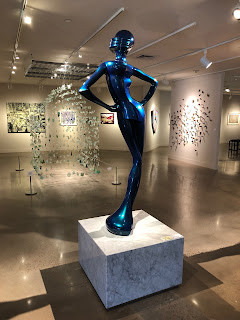"Some time during eternity
some guys show up ..."
And one of those guys who showed up 100 years ago today became an iconic figure in the world of American poetry and publishing. Lawrence Ferlinghetti is celebrating his one-hundredth birthday, and the accolades justly honor this man of American letters.
Perhaps there was a special moon dust in the air that year, the Great War just ending. For 35 years and $500 later, Mr. Ferlinghetti was in the same business. Only in his case, he’d create a home-away-from-home for anyone who felt like an ex-patriate in their own country. City Lights the store, the journal attached to it, and the publisher which grew out of it has changed the face of American letters almost as much as Harlem.
While much of the country was falling in love with “The Ten Commandments,” Ferlinghetti’s store and what it stocked beckoned its visitors to think, to be socially engaged, to challenge the monstrosity that America had become (and in many ways, always has been). “If you would be a poet,” Ferlinghetti wrote in Poetry as Insurgent Art, “create works capable of answering the challenge of/apocalyptic times, even if this meaning sounds apocalyptic.”
Mr. Ferlinghetti has dedicated his life to this project in all forms. While the US was passing a highway bill that would destroy much of the country, he was publishing Allen Ginsberg’s Howl. When his store could have become a lucrative museum of the Beats, he redirected City Lights to publishing writers from around the world, such as Daisy Zamora and Semezdin Mehmedinovic. When a great many in the US were accepting the smoking gun that could be a mushroom cloud, City Lights was hosting anti-war vigils that spilled out into Jack Kerouac alley.
I somehow discovered Ferlinghetti in my early teens after my introduction to the Beats via Danny Sugarman's biography of Jim Morrison, and it wasn't long before I was reading Howl and looking for more poetry like A Coney Island of the Mind to rattle my small town suburban existence of a 1980s Gen X youth. While never truly a poet at heart, despite my attempts to develop a withdrawn poet ethos at various times in my life, Ferlinghetti was someone I came back to whenever I need him, like when I memorized "Sometime during eternity" for a college class in oral interpretation. It may be the only poem I ever performed.
Ferlinghetti matters to American literature and culture, and it's right that we celebrate his one hundred years.
